|
|
|
Sort Order |
|
|
|
Items / Page
|
|
|
|
|
|
|
| Srl | Item |
| 1 |
ID:
191075
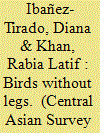

|
|
|
|
|
| Summary/Abstract |
This article examines how three generations of women in an Afghan–Turkmen family residing in Istanbul, Turkey, have experienced historical migration and legal integration. We deploy the concept of potentiality to convey these women’s experiences of legal integration as a particular form of existence that is, at times, expressed by them and other families of Afghan background with the Dari metaphor of being ‘birds without legs’. The metaphor conveys their constant mobility. Combining original ethnographic data with the analysis of historical works, we argue that families of Turkic ethnolinguistic backgrounds from Afghanistan residing in Turkey have been unable, and at times unwilling, to realize refuge, citizenship and settlement as the endpoint of their mobile trajectories.
|
|
|
|
|
|
|
|
|
|
|
|
|
|
|
|
| 2 |
ID:
191079
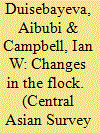

|
|
|
|
|
| Summary/Abstract |
By the end of the nineteenth century, the Russian Empire had significant economic potential. The dynamics of industrial growth influenced both territorial expansion and increased population, and the improvement of the transport system, which also contributed to the formation and development of industry. This process found its expression in the development of textile cloth production, which stimulated the growth of demand for wool and led to the development of commercial sheep-keeping. Sheep-keeping, which played a minor role on both peasant and private farms, became one of the most important economic interests of the empire. The tsarist government’s special interest in using the Kazakh steppes as a source of cheap raw materials for industry led Kazakh animal husbandry to gradually adapt to market requirements. Such changes ignored the fundamental role of traditional sheep-keeping in Kazakh culture and economic life. The loss of habitat and reduction of migration routes for Kazakhs, together with an increase in demand for livestock and livestock products, threatened the degradation of Kazakh sheep-keeping and the loss of a key element of culture.
|
|
|
|
|
|
|
|
|
|
|
|
|
|
|
|
| 3 |
ID:
191077


|
|
|
|
|
| Summary/Abstract |
Kazakhstan, seen as an example of political stability in Central Asia, recently descended into political turmoil. While the causes of the violence and unrest are the subject of ongoing analysis, their origins can be linked to systemic inequalities in a country rich in natural resources. Inter alia, Kazakhstan has failed to tackle insidious problems of corruption, particularly in public procurement contracts. Public procurement constitutes a significant amount of government spending in developing countries which makes it a high-risk area for corruption. Using primary data collected from small and medium-size enterprises organisations in Kazakhstan, this research finds that public officials and suppliers are complicit in corrupt practices. Intervention strategies, such as monitoring and control, have failed to tackle this problem. While the causes of recent political instability in Kazakhstan are multiple, corruption remains an underlying and persistent problem which will add to the fermenting discontent among the citizens of Kazakhstan.
|
|
|
|
|
|
|
|
|
|
|
|
|
|
|
|
| 4 |
ID:
191082
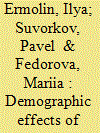

|
|
|
|
|
| Summary/Abstract |
This article explores how the deportation of the Dargin people in the Caucasus affects intergenerational fertility rates and assesses the results of the experiment. The authors paid attention to two Dargin settlements located in the foothills and Mid-Mountains areas of Dagestan, the first of which was subject to forced replacement, but the other was left intact. Inhabitants of both settlements have close kinship ties and are tied by commodity trade as well. The authors obtained data through municipal registers and an additional survey conducted in the studied localities. We used event history analysis as the main methodology. The main findings cover the following: the foothill settlers managed to keep the social norms along with handicrafts that existed before deportation which brought about the intergenerational continuity in procreative behaviour and higher childbirth rates in the foothill settlement that have persisted for a long time.
|
|
|
|
|
|
|
|
|
|
|
|
|
|
|
|
| 5 |
ID:
191080
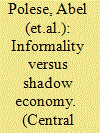

|
|
|
|
|
| Summary/Abstract |
This article is the first attempt to apply Putnis and Sauka's approach to direct measurement of the shadow economy through a survey of company managers in Central Asia. The results of the survey are used to calculate a shadow economy index for 2017 and 2018 in Kyrgyzstan, and to discuss the difference between direct and indirect methods in calculating the size of a shadow economy. We also propose a distinction between shadow economies and informality in general. While a shadow economy is usually understood to arise as a consequence of underreporting of income, we argue that informality is best understood as the aggregate of non-monetary and non-economic practices used in society. Applying this distinction to our case, we suggest that the origins of Kyrgyzstan's shadow economy are not only economic; rather social and cultural processes have had significant effects. This has implications for policy responses that address shadow economic activities.
|
|
|
|
|
|
|
|
|
|
|
|
|
|
|
|
| 6 |
ID:
191076
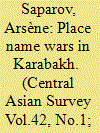

|
|
|
|
|
| Summary/Abstract |
Place names play important ideological role in the modern Armenian–Azerbaijani conflict over Karabakh. Both sides use toponymic evidence to claim a prior occupation of the disputed territory. Azerbaijan relies on the Russian maps to prove that the Armenian population are recent newcomers. Armenians point out to the medieval documents to prove the opposite. This article attempts to reconcile the contradictory evidence used by both sides by looking at the transformation of place-naming practises in the wake of the emergence of a modern bureaucratic state.
I argue that before the rise of modern bureaucratic state in Europe the place-naming was not within the realm of the state interest. The Russian conquest brought the uniformity of toponymic landscape into Caucasus where several toponymic landscapes coexisted in time and space. This resulted in elevation of one landscape into an official landscape and silencing of the other.
|
|
|
|
|
|
|
|
|
|
|
|
|
|
|
|
| 7 |
ID:
191074


|
|
|
|
|
| Summary/Abstract |
Focusing on the domestication and undomestication of nature around the River Vere in Tbilisi, Georgia, this article analyses how modernization projects seemingly overcoming nature simultaneously reinforced the complex entanglement between nature and infrastructure, the material and immaterial, the human and non-human. The article centres around a flooding event in 2015, shedding light on the entanglement of different approaches and temporalities. The river and its infrastructure are caught up with ideas, beliefs and materialities. The paper analyses how the crisis gave rise to questions about ‘morality’ of materiality, ‘proper’ and ‘improper’ handling of nature. Based on ethnography and archival work, it shows how the infrastructural developments conceived as projects of Soviet atheist modernity emerged as sites where nature, technologies and religion meet. Rather than looking at Soviet and post-Soviet as two different modernities, the article shows them as continuities.
|
|
|
|
|
|
|
|
|
|
|
|
|
|
|
|
| 8 |
ID:
191081
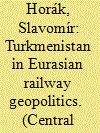

|
|
|
|
|
| Summary/Abstract |
Central Asian railways are usually discussed in the context of the Belt and Road Initiative, and most studies deal with the main railway line at the heart of this grandiose China-backed project. Turkmenistan represents a somewhat extraordinary example due to the state’s massive investments in railways, which have almost doubled the length of the country’s rail network in recent decades. The building of the new railways was aimed at linking Turkmen regions together with direct internal connections instead of relying on complicated cross-border passages. It was also intended to make Turkmenistan a transport hub of the Eurasian transport system. Based on the landlocked countries concept and using the analysis of available statistics and transport flows along the two main rail corridors passing through Turkmenistan (east–west and north–south), the paper investigates the gap between these ambitious goals and the actual results, including the reasons for these processes. The emergence of strong competition in the form of other (more efficient) routes has signified a setback for the expansion of Turkmenistan’s railway network.
|
|
|
|
|
|
|
|
|
|
|
|
|
|
|
|
| 9 |
ID:
191078


|
|
|
|
|
| Summary/Abstract |
This article argues that the Kazakh–Kyrgyz relationship in many ways shaped the emergence of Soviet Kyrgyzstan. Kyrgyz elites were willing to collaborate with Kazakhs while simultaneously trying not to be marginalized by them. Kazakh elites in the Turkestan ASSR’s government supported the first Kyrgyz nationalist project, the Kara-Kyrgyz Mountain Oblast (KKMO), in 1922. However, the division of Turkestan during the Central Asian national–territorial delimitation in 1924 and the increased linkage between national identity and political and cultural rights deprived the Kazakh–Kyrgyz regions of their socio-economic unity. Consequently, Kyrgyz leaders, to get their fair share of the disintegrating Central Asian economy as a separate group, had to contrast themselves to their Kazakh allies. The case of Soviet Kyrgyzstan shows that the intertwined relationship among Central Asian elites provides a more nuanced and complicated story of the formation of Soviet national republics in the region. Particularly, Central Asia’s settled/nomadic dichotomy and the inter-elite relationship within each population have been more influential than scholars have acknowledged.
|
|
|
|
|
|
|
|
|
|
|
|
|
|
|
|
| 10 |
ID:
191073
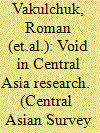

|
|
|
|
|
| Summary/Abstract |
This article assesses the extent to which the academic community engaged with climate change in Central Asia between 1991 and 2021. The article finds that climate change has been neglected in the field of Central Asia area studies. Out of a total 13,488 journal articles in eight key journals for Central Asia research, only 33 articles (0.24%) were on climate change or a related topic. Climate change has been similarly neglected at the events of 17 Central Asia area studies associations. Out of 1305 conference panels, none was focused on climate change. Out of 10,249 individual presentations, only two (0.02%) were focused on climate change. The very same scholars who have been most active in the securitization of Central Asia have ignored the severe security threats that climate change poses to the region. The article contributes to the field of Central Asian studies by drawing attention to severe knowledge gaps that hinder the Central Asian countries from adapting to climate change. It concludes with six recommendations.
|
|
|
|
|
|
|
|
|
|
|
|
|
|
|
|
|
|
|
|
|